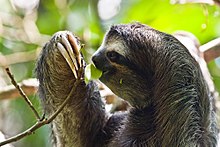Sloths
are medium-sized mammals belonging to the families Megalonychidae (two-toed
sloth) and Bradypodidae (three-toed sloth), classified into six species. Extant
sloths are arboreal (tree-dwelling) residents of the jungles of Central and
South America, and are known for being slow-moving and hence named
"sloths". Extinct sloth species include a few species of aquatic
sloths and many ground sloths. Sloths are classified as folivores, as the bulk
of their diets consist of buds, tender shoots, and leaves, mainly of Cecropia
trees. Some two-toed sloths have been documented as eating insects, small
reptiles, and birds as a small supplement to their diets. Linnaeus's two-toed
sloth has recently been documented eating human faeces from open latrines. They
have made extraordinary adaptations to an arboreal browsing lifestyle. Leaves,
their main food source, provide very little energy or nutrients, and do not
digest easily. Sloths, therefore, have large, specialized, slow-acting stomachs
with multiple compartments in which symbiotic bacteria break down the tough
leaves. Sloths' tongues have the unique ability to protrude from their mouths
10 to 12 inches, an ability that is useful for collecting leaves just out of
reach. As much as two-thirds of a well-fed sloth's body weight consists of the
contents of its stomach, and the digestive process can take a month or more to
complete.
Sloths
make a good habitat for other organisms, and a single sloth may be home to
moths, beetles, cockroaches, ciliates, fungi, and algae. Although unable to
survive outside the tropical rainforests of South and Central America, within
that environment sloths are outstandingly successful creatures. Sloths' claws
serve as their only natural defense. A cornered sloth may swipe at its
attackers in an effort to scare them away or wound them. Despite sloths'
apparent defenselessness, predators do not pose special problems: sloths blend
in with the trees and, moving only slowly, do not attract attention. Only during
their infrequent visits to ground level do they become vulnerable. The main
predators of sloths are the jaguar, the harpy eagle, and humans. The majority
of recorded sloth deaths in Costa Rica are due to contact with electrical lines
and poachers. Their claws also provide a further unexpected deterrent to human
hunters; when hanging upside-down in a tree, they are held in place by the
claws themselves and often do not fall down even if shot from below.


No comments:
Post a Comment